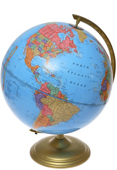Marketers who want to create loyalty programs around the world should design them with each country's needs and customs in mind. Cultural differences mean that the programs which work in North America won't necessarily translate well to other parts of the globe.
The emerging BRICS (Brazil, Russia, India, China and South Africa) markets are fertile grounds for the next generation of loyalty program participants. These countries are growing, in terms of middle-class population and economic clout, and their citizens are open to established western brands. In addition, they're eager to participate in loyalty schemes, according to a new study.
But there's more to injecting North American loyalty marketing structures into international markets than just aggressively enrolling participants, says Jim Sullivan, partner at Colloquy, which conducted cross-cultural research on attitudes toward loyalty marketing.
Colloquy's research, which included surveying more than 4,000 consumers in six countries, found consumer attitudes toward what drives loyalty vary considerably. For instance, given a list of attributes that demonstrate customer loyalty, Chinese citizens chose the number of years they patronized a company as a top indicator, even over not being price conscious or their willingness to recommend a company.

According to Colloquy, China's Merchant Bank designed a promotion with this in mind: Customers were given the opportunity to use a new Mini automobile, with the length of time they were permitted to use the car determined by their tenure with the bank.
Sullivan suggests other ways in which programs directed at the Chinese market can reflect continued patronage. For instance, currency in loyalty programs can be calculated on a one point for each yuan (or dollar) spent during the first year, two points during the second year, and so on.
This type of structure would be less effective in India, where consumers value being able to share information. Programs in the Indian market should reflect the culture's traditions of word of mouth recommendations and family ties.
"Willingness to recommend is seen in India as the number one manifestation of loyalty behavior," Sullivan says. "I would have a social aspect to any program."
Neither of these approaches would work well in Brazil, where attitudes toward money differ greatly from other developing economies. Colloquy's survey offered a list of statements about money for respondents to choose from, such as "Money is power. The more you have, the more important you are"; "Money is for spending and enjoying. Buying things makes me happy and credit cards ease my limitation" and "Money is security: The more you have saved the better you are. It's best not to spend."
Across the globe, the majority of consumers surveyed chose "Money is a tool for reaching my goals and dreams" as the statement with which they most agreed. But in most cases the second-highest choice had at least decent representation.
Not so in Brazil. Nearly nine in 10 respondents chose that statement as their top choice, with the next-highest sentiment, about security, pulling around five percent.
"I have never seen numbers like this," says Sullivan. "Across three major [economic] classes, almost the entire literate population says there is only one use for money – reaching goals and dreams." It is, he adds, a very pragmatic approach to money.
Each of these findings provides insight into how to position loyalty programs within specific markets. For India, Sullivan suggests positioning the program as a vehicle for giving consumers more power and leverage, and for putting them ahead of the pack in finding the best brands. Chinese programs, as mentioned above, should reflect consistent patronage.
"For Brazil I would be quite straightforward," he says. "I would say 'here is the contract. Earn this and get it to burn on that.' There's less of a need to appeal to their psychic need for power."
Colloquy's research on loyalty programs in emerging economies can offer a different perspective on loyalty programs in the mature North American market, according to Sullivan.
"When you see how Brazilians, Indians and the Chinese answer with such enthusiasm, it causes us to wonder about the low scores consumers are giving back in the U.S." (The study found Americans were less open to credit card spending, and less likely to expect special service for themselves. They also indicated loyalty programs were less likely to influence them to make purchases.)
"There is a certain degree of fatigue among North American consumers with regard to loyalty," Sullivan concludes. "There is an overreliance on hard benefits, and the collection, accrual and redemption of points. Consumers may think there isn't much else to these programs. If that's all there is, who cares? Marketers need to energize consumers by involving them more deeply, such as by offering emotional connection and intellectual stimulation."
 Network
Network

